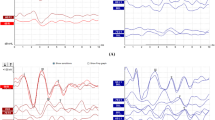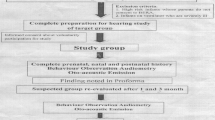Summary
Background
Hearing loss is the most common sensory disorder in developed countries and leads to a severe reduction in quality of life. In this uncontrolled case series, we evaluated the auditory development in patients suffering from congenital nonsyndromic hearing impairment related to preterm birth.
Methods
Six patients delivered preterm (25th–35th gestational weeks) suffering from mild to profound congenital nonsyndromic hearing impairment, descending from healthy, nonconsanguineous parents and were evaluated by otoacoustic emissions, tympanometry, brainstem-evoked response audiometry, and genetic testing. All patients were treated with hearing aids, and one patient required cochlear implantation.
Results
One preterm infant (32nd gestational week) initially presented with a 70 dB hearing loss, accompanied by negative otoacoustic emissions and normal tympanometric findings. The patient was treated with hearing aids and displayed a gradual improvement in bilateral hearing that completely normalized by 14 months of age accompanied by the development of otoacoustic emission responses.
Conclusions
We present here for the first time a fully documented preterm patient with delayed auditory pathway maturation and normalization of hearing within 14 months of birth. Although rare, postpartum development of the auditory system should, therefore, be considered in the initial stages for treating preterm hearing impaired patients.
Zusammenfassung
Grundlagen
Schwerhörigkeit ist die häufigste sensorische Erkrankung in den Entwicklungsländern, welche zu einer schweren Einschränkung der Lebensqualität führt. In dieser unkontrollierten Studie haben wir die auditorische Entwicklung von Frühgeborenen mit kongenitaler nicht-syndromaler Schwerhörigkeit evaluiert.
Methodik
In diese Studie wurden sechs Frühgeborene (25.-35. Schwangerschaftswoche), welche an milder bis profunder Schwerhörigkeit leiden, eingeschlossen. Alle Patienten haben gesunde Eltern, die in keinem Verwandtschaftsverhältnis zueinander stehen. Die Evaluierung erfolgte mittels otoakustischer Emissionen, Tympanometrie, Hirnstammaudiometrie and genetischer Testung. Alle Patienten wurden mit Hörgeräten und ein Patient mit Cochlear Implantation versorgt.
Ergebnisse
Ein frühgeborener Patient (32. Schwangerschaftswoche), mit regulären Tympanogrammen, hatte initial einen Hörverlust von 70 Dezibel und negative otoakustische Emissionen. Nach der Versorgung mit Hörgeräten zeigte sich eine schrittweise Verbesserung des bilateralen Hörens mit kompletter Normalisierung mit 14 Lebensmonaten, einhergehend mit positiven otoakustischen Emissionen.
Schlussfolgerungen
Wir präsentieren erstmalig einen voll dokumentierten Fall eines Frühgeborenen mit verzögerter Hörbahnreifung und Normalisierung des Hörens mit 14 Lebensmonaten. Obgleich selten, sollte eine postpartale Reifung des auditorischen Systems in den ersten Stadien der Entwicklung bei frühgeborenen schwerhörigen Patienten bedacht werden.


Similar content being viewed by others
References
Morton NE. Genetic epidemiology of hearing impairment. Ann N Y Acad Sci. 1991;630:16–31.
Ramsebner R, Volker R, Lucas T, Hamader G, Weipoltshammer K, Baumgartner WD, Wachtler FJ, Kirschhofer K, Frei K. High incidence of GJB2 mutations during screening of newborns for hearing loss in Austria. Ear Hear. 2007;28(3):298–301.
Starr A, Amlie RN, Martin WH, Sanders S. Development of auditory function in newborn infants revealed by auditory brainstem potentials. Pediatrics. 1977;60(6):831–9.
Moore JK, Linthicum FHJ. The human auditory system: a timeline of development. Int J Audiol. 2007;46(9):460–78.
Madden C, Rutter M, Hilbert L, Greinwald JHJ, Choo DI. Clinical and audiological features in auditory neuropathy. Arch Otolaryngol Head Neck Surg. 2002;128(9):1026–30.
Raveh E, Buller N, Badrana O, Attias J. Auditory neuropathy: clinical characteristics and therapeutic approach. Am J Otolaryngol. 2007;28(5):302–8.
Talero-Gutiérrez C, Carvajalino-Monje I, Samper BS, Ibáñez-Pinilla M. Delayed auditory pathway maturation in the differential diagnosis of hypoacusis in young children. Int J Pediatr Otorhinolaryngol. 2008;72(4):519–27.
Frei K, Szuhai K, Lucas T, Weipoltshammer K, Schöfer C, Ramsebner R, Baumgartner WD, Raap AK, Bittner R, Wachtler FJ, Kirschhofer K. Connexin 26 mutations in cases of sensorineural deafness in eastern Austria. Eur J Hum Genet. 2002;10(7):427–32.
Dum N, Schmidt U, von Wedel H. Frequency-dependence of early auditory evoked responses in the guinea pig. Arch Otorhinolaryngol. 1982;236(1):59–66.
Probst R, Grevers G, Iro H, editors. Hals-Nasen-Ohren-Heilkunde. Stuttgart: Georg Thieme Ltd; 2004.
Pyman B, Blamey P, Lacy P, Clark G, Dowell R. The development of speech perception in children using cochlear implants: effects of etiologic factors and delayed milestones. Am J Otol. 2000;21(1):57–61.
Acknowledgments
We would like to thank the patient and his family for cooperation and Sonja Hickmann for the audiological testing. This project was supported by funds of the Oesterreichische Nationalbank (Anniversary Fund, project number AP14058ONB).
Conflict of interest
All authors declare that they have no conflict of interest.
Author information
Authors and Affiliations
Corresponding author
Rights and permissions
About this article
Cite this article
Koenighofer, M., Parzefall, T., Ramsebner, R. et al. Delayed auditory pathway maturation and prematurity. Wien Klin Wochenschr 127, 440–444 (2015). https://doi.org/10.1007/s00508-014-0653-y
Received:
Accepted:
Published:
Issue Date:
DOI: https://doi.org/10.1007/s00508-014-0653-y




